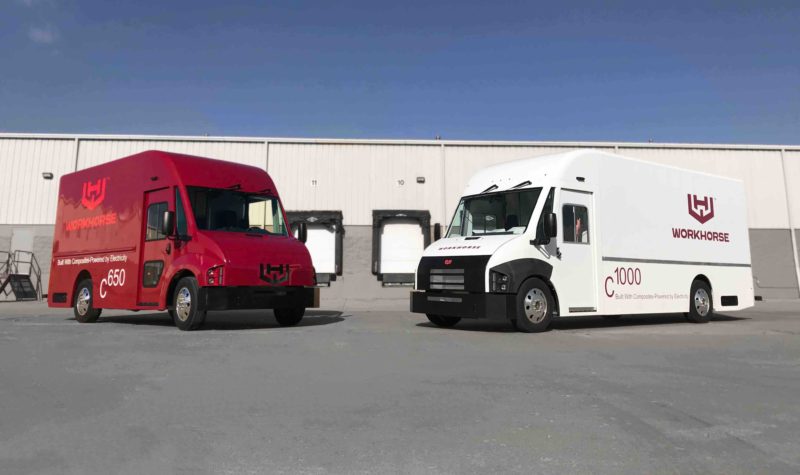American electric utility vehicle company Workhorse Group has seen its shares slump 15% after the company reported first-quarter revenue which was well down on Wall Street’s expectations, after its electric delivery van production got off to a slower start than planned.
Workhorse Group, formerly known as AMP Electric Vehicles and which was established back in 2007 as a developmental-stage vehicle electrification company, currently offers two electric delivery vehicles built specifically for Last Mile Delivery services, and its Horsefly package delivery drone.
The Workhorse C-Series vehicles are powered by a modular battery pack system which is able to provide between 35kWh when equipped with two battery packs, and 70kWh in its standard four pack configuration.
The C650 and C1000 step vans are obviously designed at the package delivery sector, with 650 cubic-foot and 1,000 cubic-foot of storage respectively and low floor design. Further, Workhorse also produces the Metron Telematics system, a multi-platform application allows you to track and monitor the performance of all Workhorse vehicles in your fleet.
In its first-quarter results published on Monday, Workhorse Group revealed sales of approximately $US521,000, well up on the approximately $US84,000 reported in the first quarter of 2020.
However, Workhorse only managed to deliver six trucks in the first quarter and produced a total of 38 C-Series vehicles – more than doubling the number produced in comparison to the combined previous three quarters.
This slow start to the year has necessitated the company adjust its 2021 production estimate down to 1,000 units – much lower than the previously promised 1,800, especially considering that Workhorse said at the beginning of March that it had an order backlog of approximately 8,000 vehicles.
To make matters worse, Workhorse also took a loss of $US136.6 million primarily due to the reduction in the fair value of its investment in electric pickup truck company Lordstown Motor Corp.
“We have had a step function improvement in production in the last month,” said Duane Hughes, Workhorse Group CEO. “Although we had planned to have achieved our year-to-date number of trucks produced sooner, we took the additional time to ensure that we were building top-quality vehicles for our customers while improving our production processes.
“Bottlenecks within the global supply chain and offshore shipping delays of commodity raw materials and components as well as our initial stages of production limited our capacity to produce during the first quarter.
“However, our vehicle production numbers in April in comparison to the last few quarters are encouraging as are the proactive steps we are taking to build our volumes and ensure consistent production.”
But Hughes’ comments were not enough to stem the tide of concern, and Wall Street’s response to Workhorse’s quarterly results was not impressed, with the company’s share price dropping 15% (as of writing).
Of course, Workhorse Group is not the only automaker to suffer from a COVID-19 impacted global supply chain. As Reuters highlighted, “major automakers including Ford Motor, Honda Motor, General Motors and Volkswagen were forced to hold back production even as car demand picked up during the COVID-19 pandemic.”
Wall Street’s conclusions must always be taken with the grain of salt that such financial assumptions always come with. For example, Bears of Wall Street have deemed Workhorse “unlikely to improve its performance in the foreseeable future” and that the company “doesn’t have enough capabilities to significantly scale the production of its electric vans.”
Worth noting, however, that Bears of Wall Street’s assumptions are designed for a specific audience, as highlighted by their final headline conclusion that Workhorse “won’t be able to create additional shareholder value in the near term.”
In terms of what Workhorse Group will be able to accomplish on the production line, however, and whether the Group will be able to attract future interest and investment in its offerings, well, only time will be able to give us those answers.
Joshua S. Hill is a Melbourne-based journalist who has been writing about climate change, clean technology, and electric vehicles for over 15 years. He has been reporting on electric vehicles and clean technologies for Renew Economy and The Driven since 2012. His preferred mode of transport is his feet.

